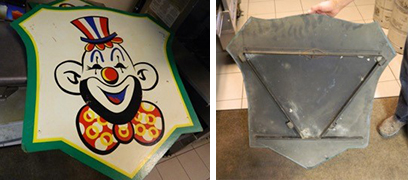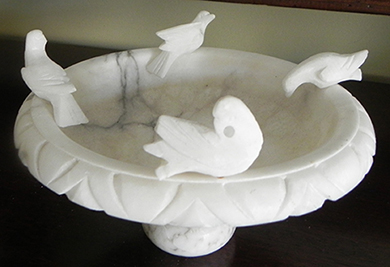 |
|
|||
 |
 |
|||
Copyright © Harry Rinker, LLC 2016 Questions
and Answers
QUESTION: I have an opportunity to purchase 15 to 20 painted signs from the Riverview Amusement Park that have been in storage since 1967. The plywood, shield-shaped signs are identical and measure 32 inches at their widest point and 34 inches high. Each features a clown’s face wearing a top hat. The back of each sign has two pipes into which flags can be inserted. The seller informed me that the signs were among the assets of a business he purchased. The first purchaser acquired them when the park closed in 1967. The signs hung in the Riverview Amusement Park parking lot, a fact I verified through Chuck Wlodarczyk’s “Riverview: Gone But Not Forgotten: A Photo-History 1904-1967.” What considerations do I need to consider if I make an offer to buy the signs? – RF, Hinckley, IL, Email Question 
ANSWER: Riverview Amusement Park was located on a 74-acre track bound on the east by Western Avenue, on the south by Belmont Avenue, on the west by the North Branch of the Chicago River, and on the north by Lane Tech High School. George Schmidt, who owned George Schmidt Motors located on the east side of Western Avenue, established the amusement park in 1904. Schmidt’s father, Wilhelm A. Schmidt, owned a “Schuetzen” (shooting) park. During a trip to Germany, George visited parks featuring carousels, Ferris Wheels, and more. Upon his return, George assumed ownership of his father’s park, renamed it “Riverview Sharpshooters Park,” and added rides. The park continued a decades long expansion, adding a roller rink and ballroom in addition to new rides. The name changed to Riverview Park in 1913. The park featured approximately 120 rides. Coasters included The Bobs, The Comet, The Silver Flash, The Fireball, and the Jetstream. The park was sold on October 3, 1967. The Schmidt family cited increasing violence and racism as primary reasons for the sale. Increasing taxes and maintenance costs also played a factor. The site is now home to the Riverview Shopping Center, the Belmont District Police Station, DeVry University, and Richard Clark Park. First, although a solid provenance is available for the signs, the signs contain no identification that they are Riverview Park related. I found no evidence that the clown image was the park’s logo. The signs have little meaning without the story behind their history. Second, the number of individuals who remember Riverview Park is declining daily. If a child was 6 in 1967, he/she would be 55 in 2016. Riverview Park is a distant memory. It will become a forgotten living memory in half a century. Third, 15 to 20 identical signs have the potential to flood the market if offered for sale at one time. They would have to be pieced into the market over a five- to ten-year period to achieve a maximum return. Fourth, the number of potential buyers is limited. The principal market is Riverview Park collectors. There should be at least a dozen in the greater Chicago area. The signs have little appeal to the generalist amusement park collector because of the lack of any wording associating them with the park. The signs do have nostalgic decorative value to those who attended the park and parked a car. Most locals arrived by public transportation rather than by car. In addition to the nostalgia market, try the ownership of the Riverview Park Shopping Center. Stress the signs’ historic display value. Fifth, the signs are large but not too large. They work as wall hangings and serve as conversation pieces. Again, the story is critical. A potential buyer needs to be persuaded that the story justifies the price. Sixth, it is not your obligation to make an offer. An offer is a free appraisal. The burden falls on the seller to set the asking price. Your responsibility is to say yes, no, or counteroffer. Finally, value is Chicago oriented. If the seller is asking $50.00 or less per sign, you might want to consider the purchase. If the asking price is $100.00, it would be a “taking a chance” purchase. Think carefully about the time and effort involved in reselling the signs, especially if sold individually. If the asking price is above $100.00 per sign, walk away. The return would never justify the time you spent trying to double or triple the purchase price. QUESTION: My grandmother kept an alabaster bowl on a mirrored piece of furniture in her foyer. I remember it as a child in the 1950s. My mother inherited it and has now passed it on to me. The round eight-inch diameter bowl rests on a pedestal foot. The rim of the bowl has an incised “U" design surround. There is a three-dimensional bird, each with a different pose, at the four quadrants of the rim. My grandmother had the “birdbath” filled with holy water. As we entered her home, we touched our fingers to the water and said “In the name of the Father, Son, Holy Ghost. Amen.” What was the initial purpose of the piece and what is its value? – SS, Email Question. 
ANSWER: Alabaster is found in two varieties – calcite and gypsum. The calcite variety, also known as Egyptian alabaster, Oriental alabaster, or onyx-marble, has been used for sculptural purposes since antiquity. It is a soft stone that is translucent and light-colored. The calcite variety has patterns of swirling bands of cream and brown. Alabaster deposits are found in the Erbo Valley in Aragon, Spain, Volterra (Tuscany / Florence is the center of the alabaster trade in Italy), and scattered locations in England and Wales. Alabaster birdbaths were extremely common in the late Victorian era and the early 20th century prior to World War I. This was an era of homes that featured large front and side porches and “naturalistic” gardens whose pathways often intersected at a mini-park featuring an alabaster birdbath on a plinth or column. Caged birds often were found in larger Victorian homes. If free to fly at will, a birdbath would be appropriate. Your aunt’s use is an adaptive one. Rather than discard it once its use had ended, she repurposed it, a woman clearly ahead of her time. Although over 100 years old or older, the secondary market demand for alabaster birdbaths is limited. Most sell for under $50.00. An example with four swirling birds perched on the rim, a footed base, and measuring 12 1/2 inches wide and 9 7/8 inches tall did sell at Philip Weiss Auctions in 2008 for $90.00. WorthPoint.com contains over a dozen comparable examples. Prices ranged from as low as $12.99 to $45.00. The true value of your alabaster birdbath is the memories it evokes of your grandmother and mother. QUESTION: I am interested in purchasing vintage Chanel jewelry. I have looked at some internet websites but am apprehensive for many reasons. Prices seem to be all over the place. What are your suggestions? – SMcC, Westchester County, NY, Email Question ANSWER: First, take time to study the market and do research. There are several books on Chanel jewelry, for example Francois Baudot’s “Chanel Jewelry” and Patrick Mauries’ “Jewelry by Chanel.” In addition, costume jewelry books usually have a chapter or section devoted to Chanel. Purchase every book you find, read them, and continue to re-read them. Second, visit www.rubylane.com and do a “Chanel Jewelry” search. Ruby Lane sets high authentication standards. No one is perfect, but Ruby Lane is better than most. As you review the listings, identify five to ten dealers. Visit their individual websites and consider establishing a buying relationship with one or more of them. Third, you are in close proximity to New York City. There are specialized antiques/vintage jewelry shows. Attend them. Study shapes, composition, attribution and pricing levels. Get to know the secondary market before buying. Fourth, Jane Clarke of Morning Glory Antiques & Jewelry in Albuquerque, New Mexico (www.morninggloryjewelry.com) is my favorite contact for vintage jewelry. She is a hunter, constantly keeping the needs of her clients in mind. QUESTION: Is there a rule of thumb on value if there are stones missing from costume jewelry or a chain is broken? – CMcD, Norfolk, VA, Email Question ANSWER: The rule is simple. Do not buy it. The time invested in finding the correct replacement stone, the cost of the stone, and the cost to do the replacement is prohibitive. Buyers want everything ready to go, whether placed in a room or pinned to a fabric. Harry L. Rinker welcomes questions from readers about
collectibles, those mass-produced items from the twentieth and twenty-first centuries.
Selected letters will be answered in this column.
Harry cannot provide personal answers.
Photos and other material submitted cannot be
returned.
Send your questions to: Rinker on Collectibles, 5955 Mill
Point Court SE, Kentwood, MI 49512.
You also can e-mail your questions to
harrylrinker@aol.com.
Only e-mails containing a full name and mailing address
will be considered.
You can listen
and participate in
WHATCHA GOT?, Harry’s
antiques and collectibles radio call-in show, on Sunday mornings between 8:00 AM
and 10:00 AM Eastern Time.
If you
cannot find it on a station in your area,
WHATCHA GOT?
streams live on the Internet at www.gcnlive.com.
SELL, KEEP OR TOSS?: HOW TO DOWNSIZE A HOME,
SETTLE AN ESTATE, AND APPRAISE PERSONAL PROPERTY
(House of Collectibles, an imprint of Random House Information Group, $17.99),
Harry’s latest book, is available at your favorite bookstore and via
www.harryrinker.com.
|
||||